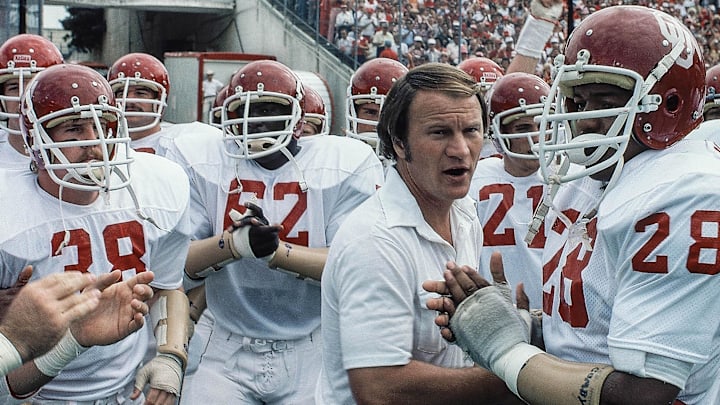Oklahoma and Michigan are two of the biggest names in the history of college football, yet they have only met one time on the football field before this year, and that only came about because of a conference rule change by the Big Ten regarding postseason bowl appearances.
Michigan's only loss in the 1975 regular season was to top-ranked and Big Ten champion Ohio State, although Big Blue had also played to a couple of ties that season. Prior to the 1975 season, the Big Ten had a rule limiting a bowl appearance by a Big Ten team to the Rose Bowl. Because Ohio State was the conference champion that season, the Buckeyes earned the automatic bid to the Rose Bowl, which would later come into play in a rewarding way for Oklahoma.
1975 was also the year that the Big Ten lifted its policy limiting bowl participation, and as a consequence, Michigan received a bid to play Big Eight co-champion Oklahoma in the Orange Bowl in Miami, Florida. Oklahoma and Nebraska shared the Big 8 title that season with identical 6-1 records.
Flash back to 1976 Orange Bowl between Sooners and Michigan
Oklahoma was ranked No. 3 in the nation in the Associated Press Top 25 headed into its Orange Bowl showdown against No. 5 Michigan. The Sooners were the defending national champions based on the AP Poll, but were playing in their first bowl game under Barry Switzer despite compiling a 32-1-1 record in Switzer's first three seasons as head coach. The only Oklahoma loss during that time was a shocking 23-3 home upset to Kansas in the 1975 season.
The Sooners were coming off of two years of NCAA probation for recruiting violations. Oklahoma did not play in a bowl game in 1973, but appeared on television twice during the season. The Sooners were banned from TV and a bowl game in 1974 and from TV again in 1975, but the restriction from bowl games was lifted in 1975, allowing OU to represent the Big 8 in the Orange Bowl.
Michigan's big weapon in the 1975 season was running back Gordie Bell, who averaged 121 yards a game for the nation's second-best rushing team. The Wolverines were quarterbacked by true freshman Rick Leach.
The 1975 Oklahoma team was loaded with current and future All-Americans, including RBs Billy Sims and Joe Washington, WRs Billy Brooks and Tinker Owens, and defensive linemen Lee Roy and Dewey Selmon.
Oklahoma opened the scoring in the Orange Bowl showdown with Michigan. Following a missed 51-yard field goal by Michigan kicker Bob Wood, the Sooners marched 79 yards for a touchdown, capped off by a 39-yard end-around reverse by Brooks to go up 7-0 in the opening quarter.
That was all the scoring in the first half, as both defenses took control of the game. Michigan drove to the Oklahoma nine-yard line in the third quarter, but a Sooner interception in the end zone thwarted that scoring opportunity.
On the first play of the fourth quarter, Davis scored on a 10-yard run to put Oklahoma up 14-0 with under 15 minutes to go.
As was the case in numerous games throughout the era of the vaunted Oklahoma Wishbone offense, the Sooners fumbled the ball four times in the Orange Bowl against Michigan and lost three of them. The Wolverines recovered one of the OU fumbles on the Sooners' two-yard line in the fourth quarter, which led to the only Michigan score in the game.
It took the Wolverines just one play after the fumble recovery, with Bell powering it into the end zone from the two-yard line. A two-point conversion attempt failed.
That's the way things ended, with Oklahoma prevailing 14-6 in a low-scoring affair between two top-5 teams. The Sooner offense recorded 345 total yards against the Michigan defense and out-rushed the run-oriented Wolverines 282-169. Michigan's Bell was held to 53 yards on the ground on 18 carries. Joe Washington had 73 rushing yards for Oklahoma.
Although Oklahoma had begun the season as the preseason No. 1 team, neither the Sooners nor anyone else in the country had envisioned No. 1 Ohio State losing in its Rose Bowl game against 11th-ranked UCLA. The Buckeyes had already beaten UCLA by a 41-20 score early in October that season. But Ohio State did, in fact, lose its 1975 rematch with the Bruins, 23-10. And as a result, Oklahoma was elevated to the top spot in the final AP Poll and awarded a second consecutive national championship.
Barry Switzer acknowledged to reporters after Oklahoma's epic Orange Bowl victory over Michigan that the Sooners were aware before taking the field against Michigan that Ohio State had lost in the Rose Bowl.
"That inspired us," Switzer said. "And we think we are the No. 1 team."
The Sooners may not be the No. 1 team this year, but they are hoping they can do enough on Saturday to prevail over a very good Michigan team for a second straight time in their two-game history. The series will grow to three games this time next season when the two iconic college football brands reverse the venue and meet again in Ann Arbor.
No. 18 OU will host No. 15 Michigan at 6:30 p.m. CT Saturday and the game will be on ESPN.
Read more about OU football
